Store closures. Bankruptcy filings. A mall turned ghost town. For nearly a decade, we have been told that brick-and-mortar retail is dying, and have seen the effects with our own eyes.
Yet at the same time, digitally native brands are venturing offline. New store concepts are popping up with fresh takes on the in-store experience. Physical retail is in fact making many valiant and creative attempts to adapt rather than succumb to inevitable death.
And while industry coverage highlights how businesses hope to profit from their ingenious new take on retail, as I read article after article I was left wondering: what about the customer?
So, I set out on an ambitious shopping experiment to test the most innovative ways you can buy a sweater in New York City. What does this innovation feel like for me, in a world where so much of my shopping behavior has moved online? Turns out, my exposure to brands on social media made it almost impossible to aimlessly browse without carrying preconceived notions. With browsing and discovery happening online, brick-and-mortar stores are no longer about “shopping” in the traditional sense – they’re about a focused hunt for a specific product or a memorable experience.
Naadam: The Fast Transaction Store
Naadam has two stores in NYC: “The $75 Sweater Store,” which only sells the brand’s iconic $75 cashmere sweater (or, as Glossy calls it, a “hero product”), and another store ten blocks away which offers the larger collection of apparel. I visited both stores, and purchased from the former.
At “The $75 Sweater Store,” my shopping experience was efficient: the store was the size of a hallway, there were three clothing racks with the $75 sweaters hanging, one dressing room, and one largely-silent sales associate. While I wouldn’t call it “shopping” – there was no thrill of combing through racks – the transaction was refreshing in its own way. As I had already been exposed to the sweater online, I knew what I wanted and my time in-store simply felt like I was running an errand to pick it up – confirming through touch and a quick try-on that what I had seen online was indeed what I wanted to purchase. For this reason, it makes sense why the store experiences are separated – one drives the quick and easy sale, while the other promotes discovery and a deeper relationship with the brand.
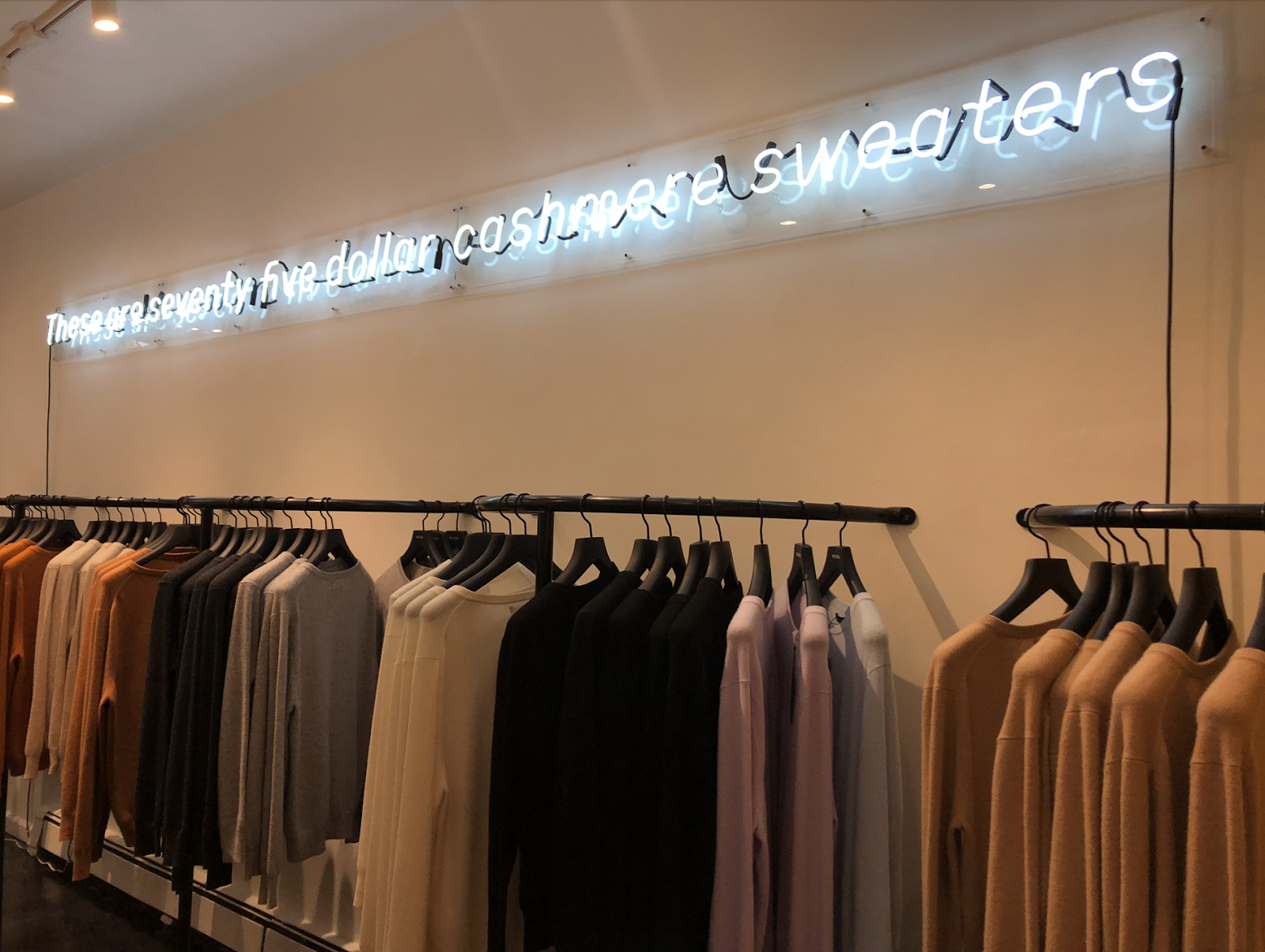
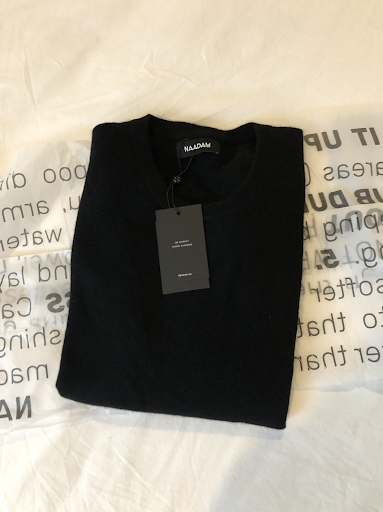
Top: “These are seventy five dollar cashmere sweaters” – the neon sign at Naadam’s “The $75 Sweater Store” ensures their store concept is crystal clear; Bottom: My ($75) sweater purchase, wrapped in paper printed with the care instructions.
Modcloth: The Stylist Store
Modcloth’s physical locations are branded as “FitShops,” where customers work with stylists to pick and try on outfits and then have them shipped home. From an operational perspective, this is ideal – because associates don’t need to house and manage inventory, the brand can rent much smaller retail locations, and associates can exercise their talents in styling customers rather than sorting product.
While I was there, I witnessed a stylist speaking with a woman who wasn’t sure if an item she was trying on was flattering. The stylist was holding a tablet open to modcloth.com, and was showing the shopper other similar styles to consider. This level of one-on-one attention is working – Modcloth customers using stylists are currently converting at 90%, compared to around 25% for those who don’t. While I myself didn’t end purchasing anything, my willingness to visit again definitely increased – Modcloth’s ability to seamlessly weave in-person interaction with the benefits of ecommerce felt like a value-add that could never be achieved by simply shopping from my couch.
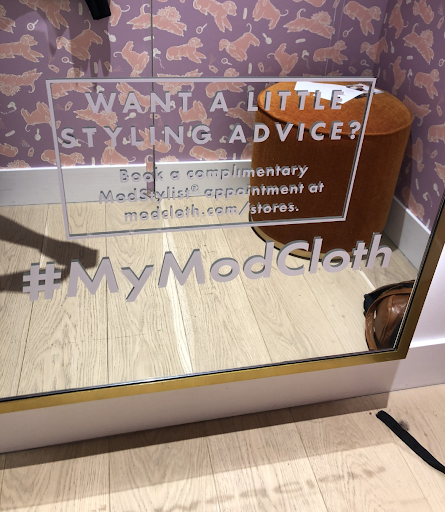
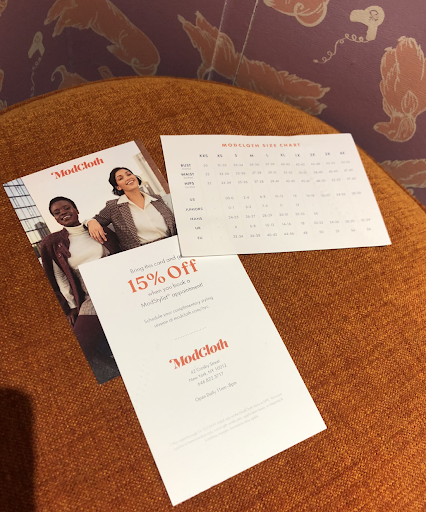
Lingua Franca: The Courageous Customizer
The hand-stitched cashmere sweater company Lingua Franca has found their niche in stitching custom phrases, especially liberal political statements (e.g. “Bad hombre” and “Blessed be the refugees”). I was visiting the store to make a statement of my own, planning on designing a sweater with one of the brand’s more popular phrases, “I miss Barack,” in the colors of my choosing. Before arrival, I was unsure whether the store was built with customization in mind, but I was pleasantly surprised to experience intense collaboration and interactivity. It was a true team process as the associate pulled sizes for me to try and brought photos up online to help me envision various sweater color / thread color combinations.
Lingua Franca is so clear about who they are and what they believe in as a brand. And due to a made-to-order business model with sweaters as the hero, the store, like Naadam’s “The $75 Sweater Store” or Modcloth, is fairly easy to operate. They can instead turn the space into a little jewel box for declaring their brand identity and building relationships. As a customer, I felt like I was joining a tribe of like-minded individuals while also enjoying the satisfaction of a personalized piece.
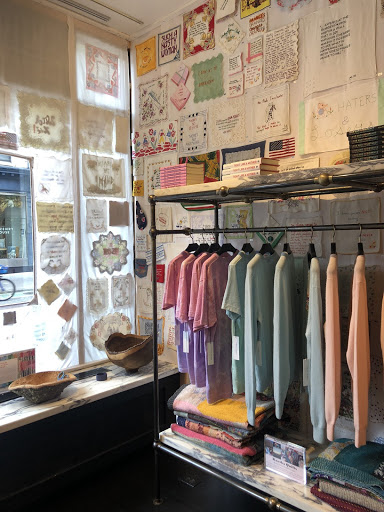
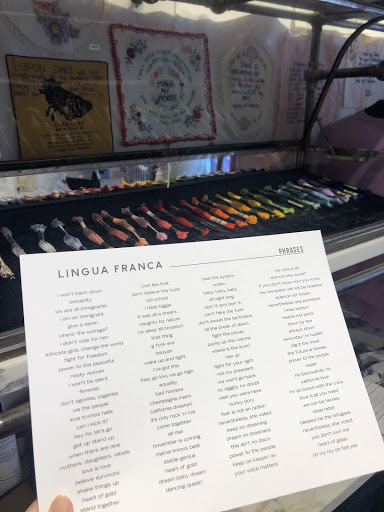
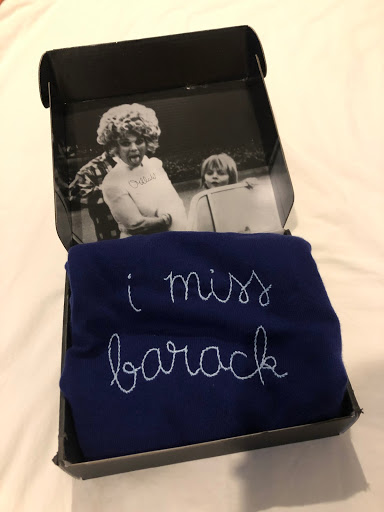
Top: A corner of the Lingua Franca store; Middle: thread is laid out and customers are provided with a card of popular phrases to help with customization; Bottom: My sweater arrives at home.
Showfields: An Experience to Instagram
I had to conclude my sweater excursion with a trip to Showfields, after reading an article declaring it “the department store of the future.” Showfields describes themselves as “the most interesting store in the world” and “an immersive theater experience that bridges art and retail.” To be honest, the mystical vagueness of it all made me a little nervous.
While there, I walked through various conjoining spaces, each temporarily owned by a brand and beautifully decorated with the help of Showfields to tell that brand’s story – Boodles Gin and Book of the Month created a library lounge area, and DTC toilet paper brand No. 2 took over the public restrooms (naturally.) It all felt a bit awkward and confusing. My mind raced with questions such as, Am I allowed to touch everything? (Yes.) Where do I try stuff on? (The one fitting room, disguised to look like a shipping container.) How do you pay? (Approach one of the associates/docents who check you out on the spot using a mobile device.) It looks like I’m the only one actually shopping – how in the world does Showfields make money? (Brands pay $4000+/month for the exposure, without much expectation of actually selling anything.)
I eye-rolled a lot, stopped in a few corners to take photos, and seemed to be the only person around who bought anything – in a space that was seemingly built for Instagramming, I ultimately felt uncomfortable making my purchase.
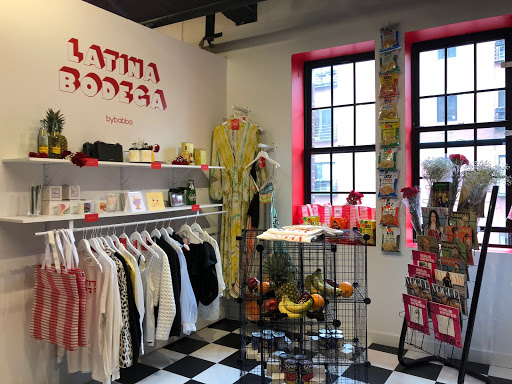
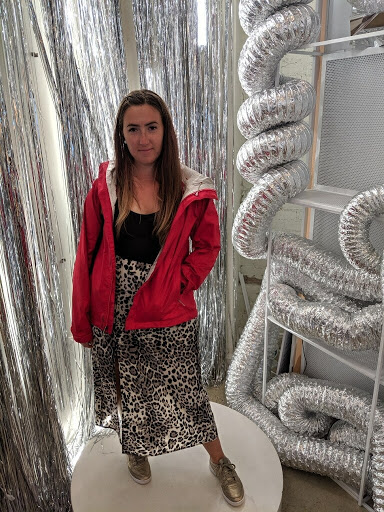
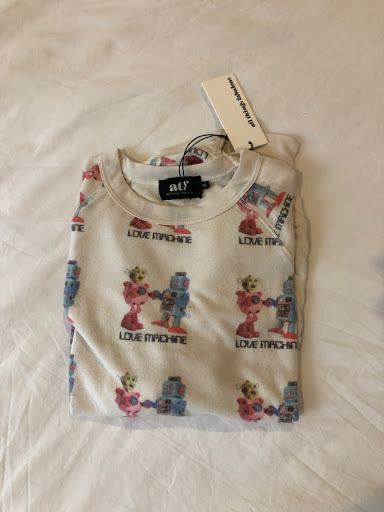
Top: One of the brand’s spaces, produced to look like a bodega; Middle: One of the many corners seemingly designed for Instagramming; Bottom: My purchase, a sweater with a print of two romantic robots
In the words of President Lincoln, four stores and several sweaters ago…
If online shopping has evolved in-person shopping into a focused hunt for a specific product or memorable experience, three things need to happen:
- The brick and mortar concept must be unique and play a clear role or provide specific value to shoppers that they couldn’t get at home.
- Brands must then use their digital marketing channels to set clear expectations of what the store experience will be like, build excitement for that experience, and drive foot traffic.
- Ecommerce, digital marketing, and physical retail must continue working together to learn and optimize towards the most positive customer experience possible.
Ultimately, retailers need to ensure that their brand personality shines through their store concept. By thinking of the space as a magnet that will attract and build relationships with “on brand” consumers, it expands the definition of a “store” from a place that encourages a sale, into a marketing platform that ultimately helps visitors align themselves with a brand and its values as they search for, Snapchat, and shop the space.
Learn more about how our retail marketing agency can help elevate your brand.



